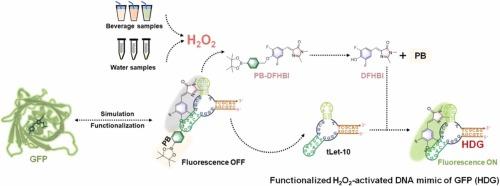Functionalized DNA mimic of GFP based on the molecule-activated chromophore derivative for hydrogen peroxide detection
IF 8
1区 化学
Q1 CHEMISTRY, ANALYTICAL
引用次数: 0
Abstract
Hydrogen peroxide (H₂O₂) plays a pivotal role in both physiological and pathological processes, which attracted considerable attention to its content analysis. Detection of certain small molecules based on DNA/RNA mimics of green fluorescent protein (GFP mimics) has been preferentially constructed due to its high specificity, excellent optical properties, and high stability. However, there is a dearth of functional GFP mimics that can be directly activated by these targets. Herein, an H2O2-activated DNA mimic of GFP (HDG) has been proposed through primarily remolding the GFP chromophore derivative named 3,5-difluoro-4-hydroxybenzylidene imidazolidinone (DFHBI) with phenyl boronate group (PB-DFHBI) and then forming the HDG by adding the truncated Lettuce DNA aptamer (tLet-10) to reveal the specifically fluorescent response toward H₂O₂. In this sensing method, the fluorescence of PB-DFHBI is markedly declined with PB group lock by restricting its intramolecular charge transfer (ICT) process, while the presence of H2O2 will activate a cascade reaction to remove the PB group in HDG, resulting in a high-contrast and turn-on fluorescence. The unique emitting mechanism triggered by H₂O₂ endows HDG with stable, rapid response, high sensitivity, and specific detection performances, exhibiting a low detection limit of 0.59 μM and a comprehensive linear range of 1–1000 μM. Moreover, HDG was allowed to realize the reliable and accurate analysis of spiked H2O2 in beverage and water samples. It is believed that the well-designed HDG will provide a promising way to establish new sensing strategies for certain target analyses and expand their applications of GFP mimics-based sensing platforms.

基于分子激活发色团衍生物的过氧化氢检测 GFP 功能化 DNA 模拟物
过氧化氢(H₂O₂)在生理和病理过程中都起着举足轻重的作用,因此其含量分析备受关注。基于绿色荧光蛋白的 DNA/RNA 模拟物(GFP 模拟物)的某些小分子检测技术因其特异性高、光学特性好和稳定性高而受到青睐。然而,能被这些靶标直接激活的功能性 GFP 模拟物还很缺乏。在此,我们提出了一种 H2O2- 激活的 GFP DNA 模拟物(HDG),主要是通过将名为 3,5-二氟-4-羟基亚苄基咪唑烷酮(DFHBI)的 GFP 发色团衍生物与苯基硼酸酯基团(PB-DFHBI)重塑,然后通过添加截短的生菜 DNA aptamer(tLet-10)形成 HDG,以揭示对 H₂O₂ 的特异性荧光响应。在这种传感方法中,PB-DFHBI 通过限制分子内电荷转移(ICT)过程锁定 PB 基团,使其荧光明显减弱,而 H2O2 的存在将激活级联反应,去除 HDG 中的 PB 基团,从而产生高对比度和开启的荧光。由 H₂O₂引发的独特发光机制赋予了 HDG 稳定、快速响应、高灵敏度和特异性的检测性能,其检测限低至 0.59 μM,线性范围为 1-1000 μM。此外,HDG 还能可靠、准确地分析饮料和水样中添加的 H2O2。相信精心设计的 HDG 将为某些目标分析提供一种新的传感策略,并扩大基于 GFP 模拟的传感平台的应用范围。
本文章由计算机程序翻译,如有差异,请以英文原文为准。
求助全文
约1分钟内获得全文
求助全文
来源期刊

Sensors and Actuators B: Chemical
工程技术-电化学
CiteScore
14.60
自引率
11.90%
发文量
1776
审稿时长
3.2 months
期刊介绍:
Sensors & Actuators, B: Chemical is an international journal focused on the research and development of chemical transducers. It covers chemical sensors and biosensors, chemical actuators, and analytical microsystems. The journal is interdisciplinary, aiming to publish original works showcasing substantial advancements beyond the current state of the art in these fields, with practical applicability to solving meaningful analytical problems. Review articles are accepted by invitation from an Editor of the journal.
 求助内容:
求助内容: 应助结果提醒方式:
应助结果提醒方式:


